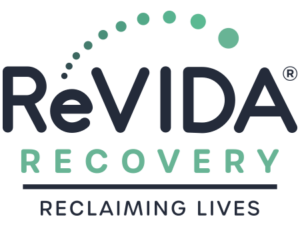
Using two or more substances is so common that it has a name: polysubstance use. Almost half of all drug overdose deaths are caused by mixing drugs. At ReVIDA Recovery, we know all of these deaths are preventable. We also know that education can save lives – especially when it comes to polysubstance use.
Two of the most commonly mixed substances are oxycodone (OxyContin®) and alcohol. Taking them together can create dangerous side effects like respiratory depression, overdose, or loss of consciousness. Today, let’s talk about oxycodone and alcohol, why they’re often combined, and why this combination can be so deadly.
Table of Contents
Oxycodone and Alcohol
Oxycodone and alcohol are both depressants, which means they work through the central nervous system to slow messages between the brain and body. For people living with trauma and anxiety, depressants can feel like a magic solution to their problems. While oxycodone was created to treat acute or chronic pain, it’s commonly misused for its depressant effects. Alcohol is often misused for its ability to create a false sense of calm, well-being, and even euphoria.
There are a number of reasons why these two substances are mixed. People may combine them to increase the effects of both substances. Others may combine them if they have an alcohol addiction and cannot stop drinking even when they’re prescribed oxycodone. Some people may combine these two by accident – they may forget that they’ve taken a pill and decide to have a few drinks. Whatever the reason, the combination of two depressants is never safe – even in small amounts.
In some social circles (and even in some areas of pop culture), combining these two substances is quite common. Because of this, many will try combining oxycodone and alcohol without an awareness of the consequences. This lack of education can lead to health complications, overdose, and even brain damage.
Depressants impact people by:
- Slowing messages between the brain and body
- Reducing inhibitions
- Slowing breathing
- Slowing reaction time
- Reducing stress or anxiety
- Enhancing mood
While many of these things might sound good, especially to someone living with a mood disorder, it’s important to consider that high doses can lead to complications in the body or central nervous system.
How Long Should I Wait Between Drinking Alcohol and Taking Oxycodone?
The half-life of oxycodone, or the time it takes for half of the substance to leave the body, is between 3-5 hours. This doesn’t mean it’s completely out of your system in 10 hours. It just means that by then, the medication has peaked and doesn’t feel as strong. It’s a common (and dangerous) misconception that you can drink a few hours after you’ve taken oxycodone. In reality, you should wait at least 24 hours after your last dose of oxycodone before drinking any alcohol. Some people may need to wait longer.
Your liver health and body mass index play a large role in how quickly substances are metabolized. If your liver is unhealthy, it will take longer to process medication. Someone with a healthy liver may metabolize oxycodone within a day, while others may take 2 or 3 days. The same can be said for your weight. Fat cells will often store excess medication for days at a time.
Dangers of Mixing Alcohol and Oxycodone
One of the largest dangers of mixing alcohol and oxycodone is respiratory depression. Because depressants impact our respiratory system by slowing it down, high doses could bring it to a complete stop. Someone experiencing respiratory distress may exhibit symptoms such as sweating, wheezing, slowed breathing, or color changes in the face, under the eyes, or around the fingernails. If you notice this in yourself or someone you love, it’s time to get immediate help. Let’s talk about other physical and behavioral risks when these medications are combined.
The Physical Risks of Combining Alcohol and Oxycodone
Some of the physical side effects that can come from mixing alcohol and oxycodone include:
- Brain damage
- Organ damage
- Overdose
- Nausea and vomiting
- Spikes or drops in blood pressure
- Loss of consciousness
- Respiratory arrest
- Irregular heart rate
- Cardiovascular distress
The Behavioral Risks of Combining Oxycodone and Alcohol
The behavioral changes that occur when these two substances are mixed is something important to consider. Behavioral changes can lead to injuries, poor decisions, irreparable damage to relationships, and more. Let’s look at a few common behavioral changes that happen when someone has combined oxycodone with alcohol:
- A feeling of “invincibility” or like nothing can hurt you
- Lowered inhibitions that may cause you to get behind the wheel or participate in unsafe sex
- Violence or aggression that is out of character, possibly causing you to hurt people or act out in a way you normally wouldn’t
- Poor decision-making, like taking extra pills or drinking more alcohol to increase euphoria or other sedative effects
Finding Treatment for Alcohol and Oxycodone Use Disorder
At ReVIDA® Recovery, we have seen firsthand how effective, evidence-based treatment can be in eliminating both alcohol and opioid use disorder (AUD and OUD). It doesn’t matter how long you’ve been taking oxycodone or how impossible it feels to stop right now – recovery is always possible. Let’s talk about some of the treatment options we offer here that could be right for you.
Medication-Assisted Treatment (MAT)
While you’re here for MAT, you’ll be closely monitored by a compassionate and knowledgeable staff. Medications are available that can help in alleviating withdrawal symptoms and guiding you safely into recovery. You’ll also have access to resources that can help you on your journey moving forward, including individual counseling, group counseling, and support groups. In an MAT program, we use medications alongside traditional therapy to guide you away from opioids and into a healthy life of recovery.
You’ll also have the option to move forward with our outpatient treatment program. If a higher level of care is warranted, we will provide referrals for a local inpatient or residential treatment program. Your clinician will go over all of your options to set you up for success.
Buprenorphine (Suboxone®) Treatment
At ReVIDA® Recovery, we support the use of buprenorphine (Suboxone®) because it has been proven to reduce cravings while working to prevent relapse. In order to receive buprenorphine (Suboxone®) treatment, you will have to be opioid-free for 24 hours.
Outpatient Rehab Services
We believe that both individual and group therapy are critical components in the treatment of Oxycodone and Alcohol Used Disorder – especially if you’re looking for long-term recovery. This is a safe and supportive space where you will learn how to manage your triggers and create healthy coping mechanisms. Our behavioral healthcare team is composed of licensed therapists, certified counselors, care coordinators, and peer recovery specialists who are standing by and ready to help. If we can treat your addiction where it started, at its roots, your chance of recovery is greater than if we were to simply treat your oxycodone withdrawal symptoms.
At ReVIDA® Recovery, we’re standing by to help you reclaim your life from oxycodone and alcohol. Approximately 70,000 people in Tennessee are managing an addiction to opioids, and you’re not alone. Recovery is possible, and you can start your journey to wellness whenever you’re ready. To learn more or to schedule an appointment, please call us today at 423-631-0432.
Frequently Asked Questions
What is oxycodone used for?
Oxycodone is typically prescribed for acute or chronic pain relief.
Can you mix painkillers with alcohol?
Mixing painkillers with alcohol, even in small amounts, comes with serious risks including respiratory distress, brain damage, organ damage, and overdose.









